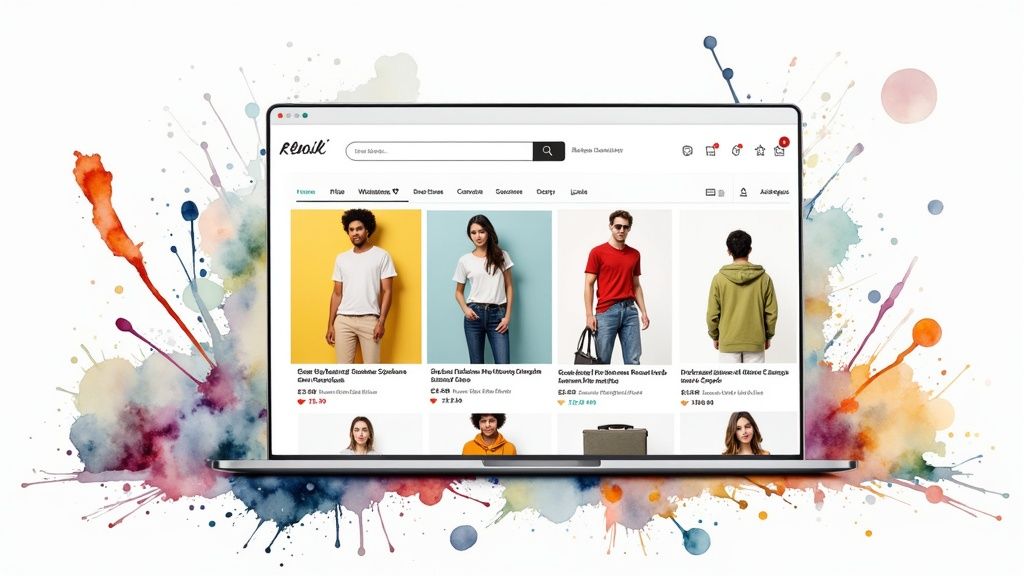Understanding Traffic Sources and Their Impact on Conversions

Every website visitor arrives with different goals and intentions. Someone clicking a targeted ad has a specific purpose in mind, while a random visitor from social media might just be browsing. Understanding where your visitors come from helps you focus your efforts on the channels that drive real results.
Identifying Your Key Traffic Sources
Your website traffic typically comes from these main sources:
- Organic Search: People finding you through Google and other search engines
- Paid Search: Visitors from paid ads like Google Ads
- Social Media: Traffic from Facebook, Instagram, LinkedIn and other platforms
- Referral Traffic: Visitors clicking links on other websites
- Direct Traffic: People typing your URL directly or using bookmarks
- Email Marketing: Visitors from your email campaigns
Recent data shows some interesting patterns. According to a study by Ruler Analytics, direct traffic converts at 3.3% on average - the highest of all sources. Some industries see even better results, with sectors like healthcare and legal services reaching conversion rates up to 5.3%. Check out more conversion stats at Blogging Wizard.
Analyzing Traffic Source Performance
To get the most from your traffic sources, track these key metrics:
- Conversion Rate: What percentage of visitors take your desired action
- Bounce Rate: How many people leave without engaging
- Average Session Duration: How long visitors stay on your site
Looking at these numbers helps you spot which channels work best and which need improvement. Use this data to make smart decisions about where to focus your time and budget.
Optimizing Underperforming Channels
When a traffic source isn't delivering results, dig deeper to find out why. Your ad message might not match your landing page content. Your social posts could be targeting the wrong audience. Keep testing and adjusting your approach for each channel until you find what works.
Optimizing Website Speed for Better Conversions

Website speed makes a real difference in online success. When visitors have to wait, they often leave before completing a purchase. Good loading times don't just make people happier - they directly boost your sales numbers. A quick-loading site means more people stick around, buy things, and help grow your business.
Finding What Slows Your Site Down
The first step is figuring out exactly what's causing delays on your website. You need to check different parts of your site to spot the slowdowns.
- Image files: Big image files are often the main culprit
- Website code: Messy or bulky code can slow everything down
- Server speed: Your hosting service affects how fast pages load
- Extra redirects: Too many page redirects create unnecessary delays
These are some common issues, but every website is different. Using speed testing tools helps pinpoint your specific problems.
Making Your Site Faster
After finding the slow spots, it's time to fix them. Making your site faster is something you'll need to work on regularly, but these key fixes can make a big difference:
- Fix those images: Shrink file sizes while keeping images clear
- Clean up code: Remove extra spaces and characters from your site's code
- Use smart caching: Let browsers save parts of your site for faster loading next time
- Pick good hosting: Get a hosting provider that keeps your site running smoothly
These changes work together to speed up your site and boost sales. The numbers show why this matters - according to Shopify, making your site just one second faster can increase sales by 7%. If your pages load in under two seconds, you could see 15% more sales. Check out more facts about this on Shopify's blog. Want to learn more about improving sales? Read about proven ways to boost your conversion rates.
Checking Your Progress
Keep track of how your speed improvements affect your business. Watch your site's performance and measure what happens when you make changes. Look at important numbers like:
- How many visitors buy something
- How many leave right away
- How fast your pages load
This helps you know if your changes are working and where to focus next. Small improvements add up over time to make a real difference in your business results.
Mastering A/B Testing for Conversion Optimization

A/B testing is the foundation of improving your website's conversion rates. By showing two different versions of a webpage to separate groups of visitors, you can measure which version performs better. Think of it like a scientific experiment - you change one element, like a headline or button, and track how it affects visitor behavior. Even small changes can lead to big improvements in your results.
Prioritizing Tests for Maximum Impact
To get the most value from A/B testing, focus on the elements that matter most. Start with the parts of your page that directly influence whether visitors take action:
- Call to Action (CTA) Buttons: Test different colors, text, sizes and locations
- Headlines: Compare various messages and formats
- Images and Videos: See which visuals connect best with visitors
- Forms: Test different lengths and required fields
Pick the elements that are most likely to impact conversions first. This helps you make the best use of your testing time and resources.
Avoiding Common A/B Testing Pitfalls
While A/B testing is straightforward in concept, getting reliable results takes careful planning. According to VWO, only one in seven A/B tests produces a winning variation. Common mistakes include running tests for too short a time and testing too many things at once. Give your tests enough time to gather solid data, and change only one element at a time so you know exactly what caused any differences in results.
Scaling Your A/B Testing Program
Once you find winning changes, build on that success by making testing a regular part of your process. Think of A/B testing as an ongoing program rather than a one-time project. Keep testing new ideas and variations regularly. This helps you stay in tune with what your visitors want and continuously improve your results. The most successful websites are always testing and refining based on real visitor behavior.
Analyzing User Behavior for Conversion Insights

Understanding how visitors interact with your website is essential for improving conversions. You need both numbers and real user insights to get the full picture. By analyzing quantitative metrics like bounce rates alongside qualitative feedback from actual users, you can identify what's working and what needs improvement. This evidence-based approach helps you make smart changes that increase conversions.
Using Quantitative Data to Identify Trends
The numbers tell an important story about how people use your site. Key metrics like bounce rate, time on page, and conversion rate show which pages perform well and which ones struggle. For instance, if visitors quickly leave a product page, it might point to slow loading, confusing navigation, or content that doesn't match their needs. Breaking down these metrics by user segments like demographics or behavior patterns often reveals even more useful insights.
Uncovering the "Why" With Qualitative Data
While numbers show what visitors do, user feedback explains why they do it. Heatmaps create visual maps of where people click and scroll, highlighting both popular areas and friction points. Session recordings let you watch real user journeys to see exactly how people navigate your site and where they get stuck. Direct feedback through surveys adds context by revealing visitors' goals and frustrations.
Looking at both types of data gives you a clear view of user behavior and conversion opportunities. Start by reviewing basic metrics like bounce rates and traffic sources, then dig deeper with tools like session recordings to understand specific interactions. Check out more statistics here. This approach helps you make decisions based on evidence rather than guesses. For more guidance, see: How to master marketing data analysis.
Turning Insights into Actionable Strategies
The goal is to turn your findings into specific improvements that boost conversions. If heatmaps show users missing an important button, try redesigning it or moving it to a better spot. When session recordings reveal form completion problems, simplify the fields or improve the layout. Focus on fixing the actual issues you uncover to create a website that better serves your visitors' needs.
Crafting High-Converting CTAs and Landing Pages
Landing pages and Calls to Action (CTAs) work together to turn website visitors into customers. A successful landing page needs a clear message about your value and guides people to take action. The key elements include strong headlines, persuasive writing, and smartly placed CTAs. Let's look at how to make these work better for higher conversions.
The Power of a Compelling Headline
Your headline needs to grab attention right away since it's the first thing visitors see. Skip generic greetings like "Welcome to Our Website" and focus on real benefits - for example, "Increase Your Sales by 20% with Our Proven Strategies." This tells visitors exactly what they'll gain from your offer.
Designing an Effective Page Layout
Think of your landing page like a road map leading to your CTA. Use visual hierarchy to make important elements stand out. Put your CTA where visitors can see it without scrolling. Add plenty of white space to keep things clean and focused. Just like a messy store turns away customers, a cluttered page makes visitors leave without converting.
Creating CTAs That Resonate
Your CTA is what turns browsers into buyers. Keep it simple and action-focused with phrases like "Get Started," "Download Now," or "Learn More." Make buttons pop with contrasting colors that catch the eye. Test different versions to see what your audience likes best. For more insights, check out our guide on how to master engaging content.
Building Trust and Authenticity
While good design and copy matter, trust matters more for lasting success. Include social proof like customer reviews to build confidence. Show security badges near payment buttons to make visitors feel safe. Keep your message honest - skip the hype and focus on real value. Think of it like building relationships in person - pushing too hard for a sale puts people off, but building trust leads to loyal customers who come back.
Measuring and Scaling Conversion Success
Getting better conversion rates requires a systematic, data-driven approach to improvement. Like navigating a ship, you need to constantly monitor conditions and adjust your course. Let's explore how to build an effective system for ongoing conversion optimization.
Building Your Measurement System
To improve what matters, you need clear metrics. Start by defining your Key Performance Indicators (KPIs). While your overall conversion rate is important, look deeper at metrics like:
- Traffic Source Conversion: Which channels bring in the most engaged visitors?
- Small Wins: Are users taking steps like newsletter signups or adding items to cart?
- Customer Value: What's the average revenue per customer over time?
These numbers tell you where to focus. For instance, if visitors from one source leave quickly, your ad message might not match your landing page content.
Growing What Works
After finding successful tactics through testing, expand them thoughtfully across your business. Like a restaurant opening new locations, you need to adapt to each context. A landing page that works for one product line might need adjustments for different customer segments.
Keeping the Momentum
Long-term success depends on consistent testing and measurement. Track your KPIs regularly, run A/B tests on new ideas, and document everything you learn - just like a scientist's lab notes. This creates a valuable record for future improvements.
Share your findings clearly with your team and stakeholders. Use simple data visualizations to show both wins and lessons learned. When everyone understands the impact, they're more likely to support future optimization work and stay focused on getting better results.
Ready to turn your content into videos that convert? Aeon helps publishers create engaging video content at scale. See how Aeon can improve your conversion rates.